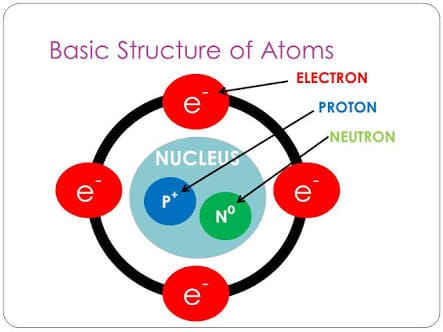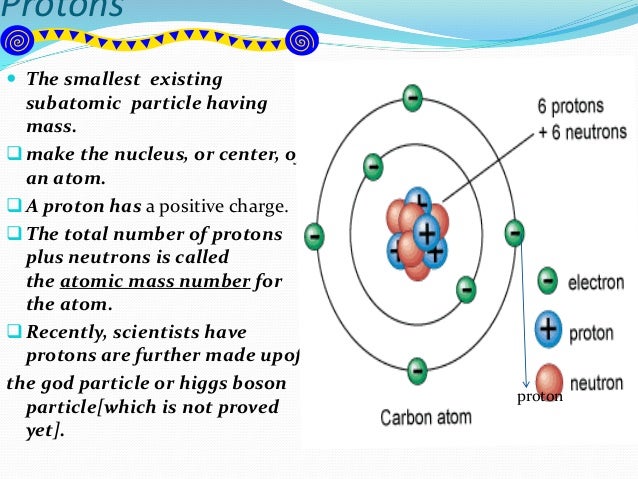Quarks are the smallest entities we have come across in our scientific endeavor through the sand grain. Actually, quarks as well as electrons. When physicists first collided electrons with protons, they observed that electrons bounced off three small hard cores inside the proton. The simplest way to define the atom is as the smallest particle in which a chemical element can be divided, without losing its chemical properties. At present it is known that there are particles much smaller than the atom and that is where the subatomic particles enter. But there’s one subatomic particle that’s far smaller still, and not even the most powerful particle accelerator has come close to pinning down its size: the electron. A.) Electrons are the smallest subatomic particle and have a negative charge, while protons and neutrons are approximately the same size as each other and have no charge. B.) Electrons are the largest subatomic particle and have a negative charge, while protons have a positive charge and neutrons have no charge. The electron is the lightest stable subatomic particle known. It carries a negative charge which is considered the basic charge of electricity. An electron is nearly massless. It has a rest mass of 9.1x10-28 gram, which is only 0.0005 the mass of a proton.
Background
The neutrino, also referred to as the electron neutrino, is the lightest and smallest of any elementary particle that has been discovered thus far. It was first proposed by Wolfgang Pauli in 1930 and then detected in experiments in 1956. It is an electrically neutral particle that is found in the weak force, nuclear reactions (such as the process in stars) and some particle collisions. The majority of neutrinos found on Earth originate from the Sun, referred to as solar neutrinos. In fact, billions of neutrinos pass through an area the size of a human fingernail each second. Neutrinos are incredibly small, and because they are neutral and not attracted to particles, they rarely hit another particle in an atom. They can pass through the entire Earth without any collision.
A strange property of the neutrino (ve) is the ability to oscillate to become larger and increase mass. It can become a muon neutrino (vu) or a tau neutrino (vt). Both of these larger particles are still neutral and belong to the neutrino family. The three neutrinos are also a part of the lepton family of particles, which include the electrically charged electrons (electron, muon electron and tau electron).
Explanation
In energy wave theory, the neutrino is the likely candidate for a single wave center, which makes it the fundamental particle that creates other particles. Other particles are made from a collection of wave centers (K) in a particle, similar to how atomic elements are formed from a collection of protons in a nucleus. A single wave center reflecting spherical, longitudinal waves to create standing waves would look like this:
Neutrino – Standing Waves of Energy from a Single Wave Center
Neutrino Oscillation and Decay
Neutrino oscillations have been found in nature. The neutrino may oscillate to become a larger muon neutrino and a muon neutrino can become a tau neutrino. This occurs naturally as trillions and trillions of neutrinos arrive on Earth from the Sun. As it was found using the Longitudinal Energy Equation from the wave constant form of the equations:
- The neutrino has a particle count of 1
- The muon neutrino has a particle count of 8
- The tau neutrino has a particle count of 20
The reason that neutrinos are found to oscillate is that the chance of 20 or less neutrinos randomly merging may occur in nature – kinetic energy traveling from the Sun. This is consistent with neutrino experiments.
The reason other particles do not oscillate naturally is because they require higher energies to form. Particles with higher particle counts (more than 20) require high-energy experiments such as particle accelerator labs to generate the kinetic energy to combine and form particles. This is consistent with particle accelerator experiments.
Neutrino and the Lepton Family
It is proposed that leptons are slightly more stable, and hence found in nature, because of geometric configurations that are similar to protons and neutrons in the atomic nucleus. The neutrino family would be relatively stable at these proposed geometric structures (left side of the figure below). At particle counts of 1 (neutrino), 8 (muon neutrino) and 20 (tau neutrino), they are possibly symmetric tetrahedrons, which means they may have no charge if the two tetrahedrons spin in opposite directions. This leaves the possibility of discovering more neutrinos, especially one with a particle count of 2 (K=2), given the similarity of particle counts to the magic number sequence in atomic number counts seen in elements. It would have a rest energy around 110 eV. By comparison, the particle counts for other leptons (electron, muon electron and tau electron) are shown in the right side of the figure. The electron family may also be tetrahedral structures, but non-symmetric. Therefore, as the particle spins, it creates the transverse wave found in the magnetic force.

Comparison to Atomic Elements

If neutrinos can oscillate up to a count of 20 (tau neutrino), then what about the other arrangements? For example, why are neutrinos with particle counts of 2, 3, 4, 5, 6 or 7 not found? The next neutrino that is found is the muon neutrino with a particle count of 8. Wave centers centers must be at the nodes of standing waves to be stable and the other geometric arrangements likely do not lead to this stability.
What Is The Smallest Subatomic Particle Called
As described in the calculations of particles, leptons appear at the same magic numbers found in atomic elements. Update for insignia gps. The numbers 2, 8, 20, 28, 50, 82, 126 are special in the atomic world because a combination of the stability of these atoms when their nucleons contain these numbers (number of protons or neutrons). The magic numbers align with the orbital shells and how electrons fit within the orbit surrounding the nucleus. Nuclear binding energy levels are found to be higher in these numbers.
Credit: Hyperphysics
Magic Numbers in Atomic Elements
Proof
Smallest Subatomic Particle Known To Man
Proof of the energy wave explanation for the neutrino is the calculations and explanation of:
- Neutrino oscillation – see above
- Neutrino energy – see below
- Muon and tau neutrino energies – see calculations page
Neutrino Energy – Calculation
The calculation of the electron neutrino’s energy assumes spherical volume (V) and a radius (r) of one wavelength before standing waves transition to traveling waves. It also assumes that wave amplitude (A) is longitudinal from three dimensions (cubed) and it decreases with the square of the distance. The Longitudinal Energy Equation is used with a single variable – particle count (K) to calculate rest energy. For the neutrino, there is one wave center (K=1).
Neutrino – Geometry
Equation: Longitudinal Energy Equation
Variables:
- K=1
Identify The Smallest Subatomic Particle
Result: 3.83E-19 joules (kg m2/s2)
Comments: Using the equation and wave constants, the result is 3.83E-19 joules or 2.39 eV. This is on the high-end of the neutrino’s expected range (~2.2 eV), but the neutrino’s exact energy is still being determined in experiments.
The realization in the late 1960s that protons, neutrons, and even Yukawa’s pions are all built from quarks changed the direction of thinking about the nuclear binding force. Although at the level of nuclei Yukawa’s picture remained valid, at the more-minute quark level it could not satisfactorily explain what held the quarks together within the protons and pions or what prevented the quarks from escaping one at a time.
The answer to questions like these seems to lie in the property called colour. Colour was originally introduced to solve a problem raised by the exclusion principle that was formulated by the Austrian physicist Wolfgang Pauli in 1925. This rule does not allow particles with spin1/2, such as quarks, to occupy the same quantum state. However, the omega-minus particle, for example, contains three quarks of the same flavour, sss, and has spin 3/2, so the quarks must also all be in the same spin state. The omega-minus particle, according to the Pauli exclusion principle, should not exist.
To resolve this paradox, in 1964–65 Oscar Greenberg in the United States and Yoichiro Nambu and colleagues in Japan proposed the existence of a new property with three possible states. In analogy to the three primary colours of light, the new property became known as colour and the three varieties as red, green, and blue.

The three colour states and the three anticolour states (ascribed to antiquarks) are comparable to the two states of electric charge and anticharge (positive and negative), and hadrons are analogous to atoms. Just as atoms contain constituents whose electric charges balance overall to give a neutral atom, hadrons consist of coloured quarks that balance to give a particle with no net colour. Moreover, nuclei can be built from colourless protons and neutrons, rather as molecules form from electrically neutral atoms. Even Yukawa’s pion exchange can be compared to exchange models of chemical bonding.
This analogy between electric charge and colour led to the idea that colour could be the source of the force between quarks, just as electric charge is the source of the electromagnetic force between charged particles. The colour force was seen to be working not between nucleons, as in Yukawa’s theory, but between quarks. In the late 1960s and early 1970s, theorists turned their attention to developing a quantum field theory based on coloured quarks. In such a theory colour would take the role of electric charge in QED.
It was obvious that the field theory for coloured quarks had to be fundamentally different from QED because there are three kinds of colour as opposed to two states of electric charge. To give neutral objects, electric charges combine with an equal number of anticharges, as in atoms where the number of negative electrons equals the number of positive protons. With colour, however, three different charges must add together to give zero. In addition, because SU(3) symmetry (the same type of mathematical symmetry that Gell-Mann and Neʾeman used for three flavours) applies to the three colours, quarks of one colour must be able to transform into another colour. This implies that a quark can emit something—the quantum of the field due to colour—that itself carries colour. And if the field quanta are coloured, then they can interact between themselves, unlike the photons of QED, which are electrically neutral.
Smallest Subatomic Particle In An Atom
Despite these differences, the basic framework for a field theory based on colour already existed by the late 1960s, owing in large part to the work of theorists, particularly Chen Ning Yang and Robert Mills in the United States, who had studied similar theories in the 1950s. The new theory of the strong force was called quantum chromodynamics, or QCD, in analogy to quantum electrodynamics, or QED. In QCD the source of the field is the property of colour, and the field quanta are called gluons. Eight gluons are necessary in all to make the changes between the coloured quarks according to the rules of SU(3).
